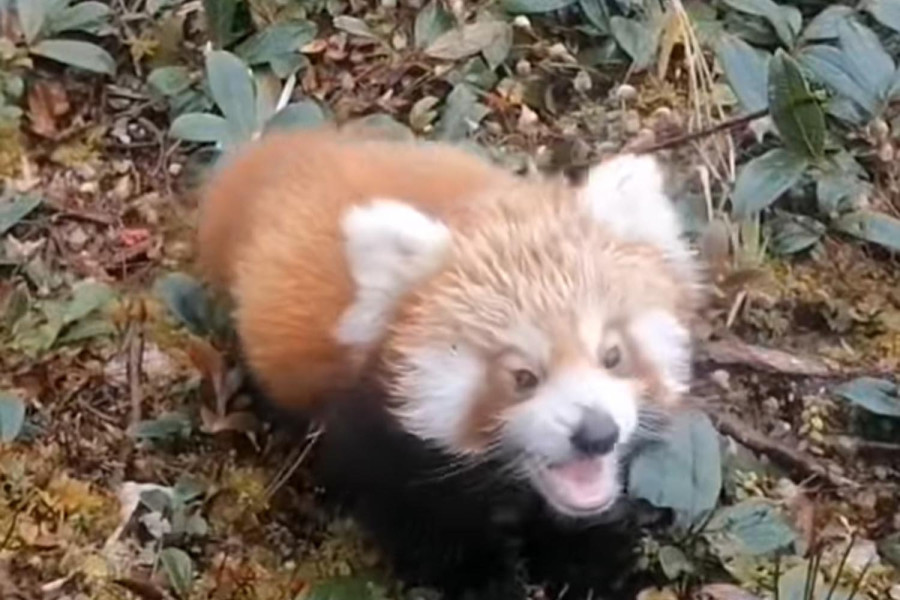Koshi Province
Red panda sighting in Pathibhara area hints at conservation success
Threats to the animal’s existence, however, remain intact, with their corpses being recovered regularly.
Ananda Gautam
About two months ago, Rajendra Mahat, a Pathibhara temple staff, came across a pack of red panda cubs on his way back from the temple. Mahat recorded the pack on his mobile phone and, with the help of locals, escorted them towards the forest away from humans.
Although Taplejung is a habitat for red pandas, known as Habre locally, this was the first time Mahat had seen a pack in the Pathibhara area. “There were three cubs in the pack,” Mahat said. “Red panda sightings are rare, so it was a pleasant surprise for me.”
The pack sighting can be considered a good sign indicating a growth in the population of the endangered species and the success of conservation efforts, Mahat says. However, of late, the locals have also recovered red panda corpses in some areas, raising concerns about their safety.
According to the data collected from different organisations, in the past dead red pandas were found in Deurali, Sewarochok, Bhalugaide and other areas. The District Veterinary Office in collaboration with the Division Forest Office, Red Panda Network and the Himalayan Conservation Forum had conducted the post-mortem on the red panda corpses. The post-mortem report had revealed that the likely cause of death of the red pandas was attacks from Yellow-throated marten and dogs.
“Even now stray dogs pose a major challenge in the conservation of the red pandas,” said Wangchuk Bhutia, programme coordinator of the Red Panda Network. “The Red Panda Network has been running sterilisation camps for three years to reduce the number of stray dogs but we have not been able to fully control their population.”
Stating that poaching of red pandas is still not under control, Bhutia calls for increased vigilance from the authorities. “Miscreants still hunt for these animals and it is becoming increasingly difficult to keep them in check,” he said.
According to Bhutia, the network has established a research centre in Deurali given the concentrated population of the red panda in the area.
Ramesh Rai, programme coordinator at the Himalayan Conservation Forum working in Taplejung, says conservation workers conducted a study in the Pathibhara region before the COVID-19 outbreak. “The study pointed out the necessity to turn the Pathibhara area into a protected area for red pandas,” said Rai. “We have been maintaining a database and collecting information on red pandas to declare this area a protected habitat. The authorities are finally paying some attention to the conservation of this endangered species.”
According to Suraj Ojha, president of the Federation of Community Forestry Users Nepal, community forests in Taplejung have also been following strict rules for red panda conservation during the animal’s breeding season. Back in July, the federation issued a temporary ban on human entry into forest areas, aimed to protect the endangered red pandas. The ban was in effect from mid-July to mid-September in 14 community forests in the district.
All the community forests in the district have red panda conservation plans adapted in their annual action plan, Ojha said. “The breeding season for red pandas begins at the end of May and lasts until the end of July and entry for all humans into the forest areas is restricted during this period,” he said. “The mortality rate of red panda cubs tends to be high in the following months, until mid-September.”
According to a study conducted six years ago by the Red Panda Network, red pandas are found in 23 districts in Nepal. In the east, they are found in the hilly districts of Taplejung, Panchthar, Ilam, Khotang, Sankhuwasabha and Bhojpur. It was estimated that there are around 300 red pandas in Taplejung, Panchthar and Ilam.
Among the mammals, this species is listed in schedule 1 under the National Parks and Wildlife Conservation Act 1973. Red pandas have a round head, large pointed ears, and a pointed tail with mostly red and white fur. They survive on Himalayan bamboo leaves. Red pandas are mostly found in Nepal, Sikkim, Burma and South China.




 7.12°C Kathmandu
7.12°C Kathmandu















